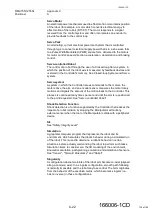
C-22
166006-1CD
166006-1CD
Appendix C
S
RM2-755/1255SL
Positioner
Servo Motor
An electrical power mechanism used to effect motion or maintains position
of the robot (for example, a motor which converts electrical energy to
effect motion of the robot) (R15.07). The motor responds to a signal
received from the control system and often incorporates an encoder to
provide feedback to the control loop.
Servo Pack
An alternating, current electrical power mechanism that is controlled
through logic to convert electrical supply power that is in a sine wave form
to a Pulse Width Modulated (PWM) square form, delivered to the motors
for motor control: speed, direction, acceleration, deceleration and braking
control.
Servo-controlled Robot
The control of a robot through the use of a Closed-loop Servo-system, in
which the position of the robot axis is measured by feedback devices and
is stored in the Controller's memory. See Closed-loop System and Servo-
system.
Servo-system
A system in which the Controller issues commands to the motors, the
motors drive the arm, and an encoder sensor measures the motor rotary
motions and signals the amount of the motion back to the Controller. This
process is continued many times per second until the arm is repositioned
Shock Detection Function
Shock detection is a function supported by the Controller that reduces the
impact of a robot collision by stopping the Manipulator without any
external sensor when the tool or the Manipulator collide with a peripheral
device.
SIL
Simulation
A graphical computer program that represents the robot and its
environment, which emulates the robot's behavior during a simulated run
of the robot. This is used to determine a robot's behavior in certain
situations, before actually commanding the robot to perform such tasks.
Simulation items to consider are: the 3D modeling of the environment,
kinematics emulation, path-planning emulation and simulation of sensors.
,
Singularity
A configuration where two joints of the robot arm become co-axial (aligned
along a common axis). In a singular configuration, smooth path following
is normally impossible and the robot may lose control. The term originates
from the behavior of the Jacobian matrix, which becomes singular (i.e.,
has no inverse) in these configurations.
139 of 145


























